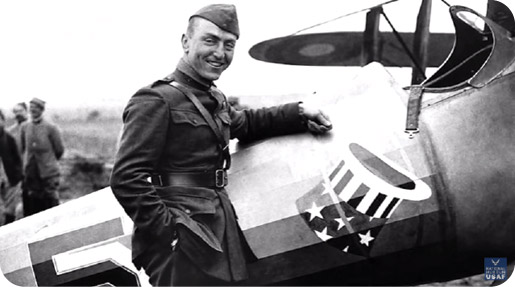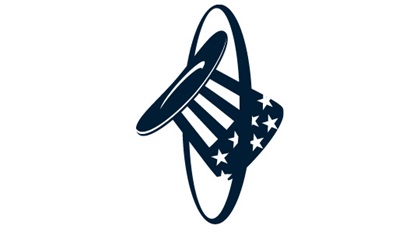
AOPA Foundation
Be like Eddie
Throw your hat in the ring
More than 100 years ago, the U.S. Army 94th Aero Squadron was sent to France to see combat on World War I’s western front. The squadron’s aerial achievements ensured its place in history as a unit of heroism and renown. The Nieuport 28 C1 and SPAD XIII fighters flown by the 94th Aero Squadron bore a distinctive insignia: an American flag motif top hat within a ring. Several members of the unit, which came to be known as the Hat in the Ring Squadron, became air aces, shooting down enemy aircraft including fighters, reconnaissance airplanes, and observation balloons. The unit’s aces included Eddie Rickenbacker, America’s top-scoring World War I ace with 26 victories, who became a recipient of the Medal of Honor and would play an important role in civil aviation as the leader of a U.S. airline.
Michael Goulian, Hat in the Ring Society Chair: “Aviation has been both a vocation and avocation for me. There is no passion on Earth like ours for flying. We’re a tightknit community and there are so many ways to give back to general aviation. I am happy to be part [of] one of those ways—an important one.”Inspired by the rich history of the 94th Aero Squadron, its heroes, and their meet-any-challenge spirit, the AOPA Foundation, the charitable arm of AOPA, created The Hat in the Ring Society, a venue for philanthropic pilots to “throw their hats in the ring” each year with charitable donations between $1,000 and $9,999.
As the AOPA Foundation’s longest-running philanthropic-giving circle, the Hat in the Ring Society makes a significant and lasting difference in general aviation’s future, thanks to its members’ generosity.
Paul Heintz, 25-year supporter: “I support the AOPA Foundation because its main focus today is on encouraging people to fly, continue to fly, and to fly safely. That effort is crucial to the health of the GA industry and to the strength of its foremost advocate, AOPA, which exists to preserve our freedom to fly. My membership in the Hat in the Ring Society is meaningful to me because it is a great way to support my 63-year passion for flying and helps me share that passion with others.”AOPA’s You Can Fly program and Air Safety Institute are supported through philanthropic contributions to the AOPA Foundation. The You Can Fly program seeks to engage young people in aviation science, technology, engineering, and math education in school; support flight training providers; make aviation more affordable and accessible through flying clubs; and help bring lapsed pilots back into aviation. For more than 60 years, the AOPA Air Safety Institute has been producing free programs to help all pilots fly safer. From insightful accident analysis to award-winning videos, online courses, podcasts, and more, ASI is guiding GA safety culture by influencing pilot behavior, policy makers, and training providers.
Medically Speaking
Heart to heart
Lifestyle changes to prevent heart disease
By Gary Crump
Heart disease continues to be the number one cause of death in the United States, making up about 23 percent of deaths in this country in 2018. About 659,000 Americans die from heart disease each year.
Because heart disease is so prevalent, it’s understandable that many of the pilots we work with in the AOPA Pilot Information Center medical group are being treated for these conditions, and are dealing with the FAA to acquire a special issuance medical authorization. Equally not surprising, the FAA does more special issuances for cardiovascular disease than any other medical pathology. About 13,000 cardiac special issuances are granted annually for all three classes of medical certification. That’s more than one-third of the total special issuances for all the other medical conditions that require discretionary issuance.
In his book Prevent and Reverse Heart Disease, Dr. Caldwell Esselstyn, a former cardiovascular surgeon at the Cleveland Clinic, outlines his treatment for preventing and, in many cases, reversing heart disease through a rigid change in diet. His plan is simple, but it requires a dramatic change in how we eat:
- You may not eat anything “with a mother or a face” (no meat, poultry, or fish).
- No dairy products.
- No oil of any kind, not even olive oil.
- No nuts; no avocados.
It is dramatic and excludes just about everything that most of us consider dietary staples. However, if you love fruits and vegetables, the news is good; you can eat just about anything in the fruit and vegetables part of the food pyramid (except avocados!). Also, you can have whole grains and legumes (beans).
Esselstyn strongly advocates for a total cholesterol of less than 150 mg/dL. That’s considerably less than the “desirable” level of under 200 mg/dL that is considered “healthy.” He is adamant that lower cholesterol levels will result when his dietary recommendations are followed.
I try to pay attention to my diet, but I’ll be the first to admit that as a native Texan giving up red meat, along with fish and poultry, will be a challenge. Not to mention how much I love milk and cheese, and buttermilk! Although I don’t have a family or personal history of heart disease, I’m going to give this diet a go, albeit with maybe a cheat meal on occasion just to keep the gas grill operating this winter.
Gary Crump is director of medical certification for the AOPA Pilot Information Center.
 As bronze-level members, donors throw their “hat in the ring” and lend their support to help address challenges facing general aviation with an annual contribution of $1,000 to $2,499. Silver-level members contribute $2,500 to $4,999 and gold-level members contribute $5,000 to $9,999. All members receive these benefits:
As bronze-level members, donors throw their “hat in the ring” and lend their support to help address challenges facing general aviation with an annual contribution of $1,000 to $2,499. Silver-level members contribute $2,500 to $4,999 and gold-level members contribute $5,000 to $9,999. All members receive these benefits:

